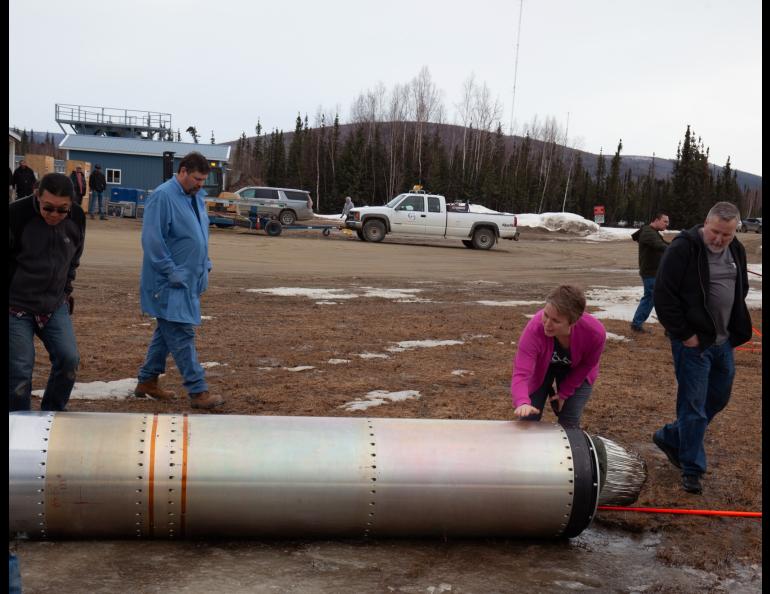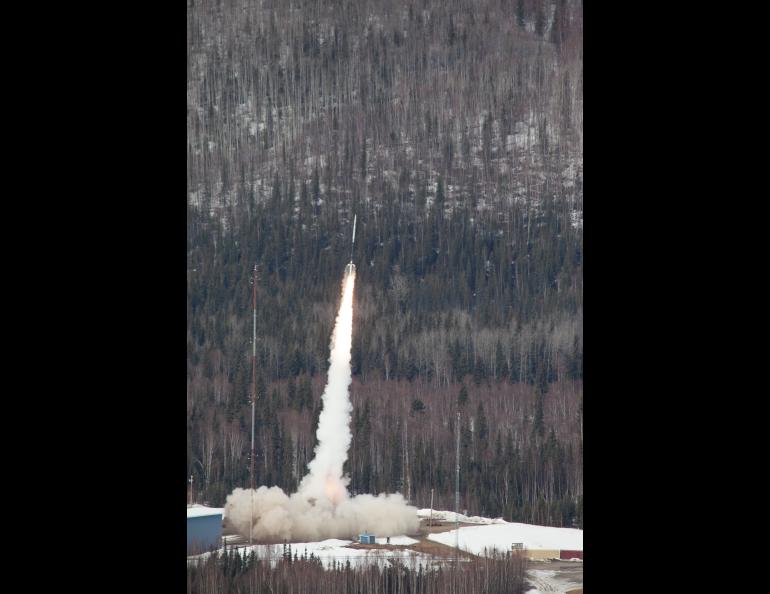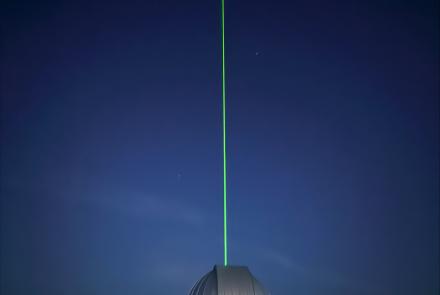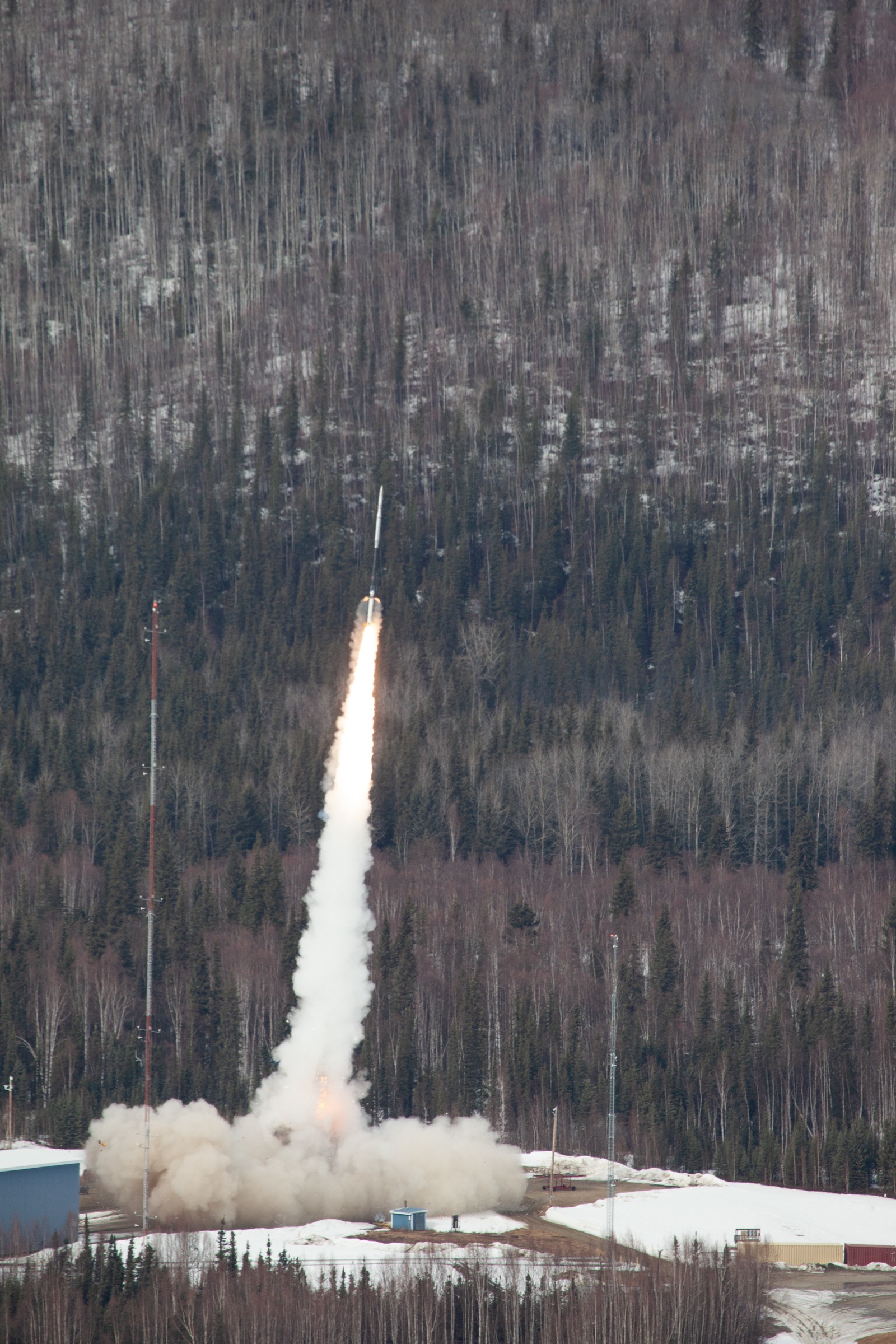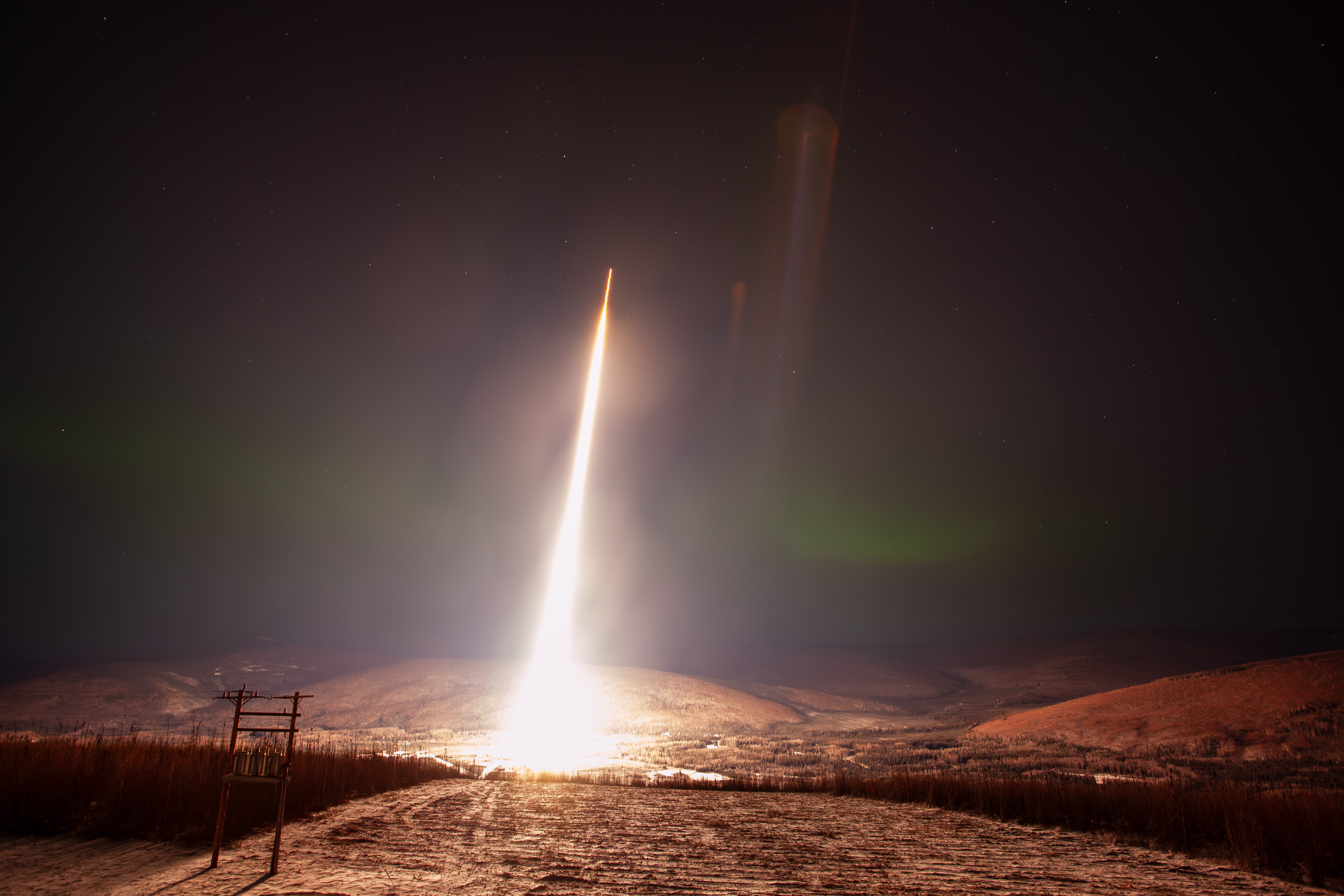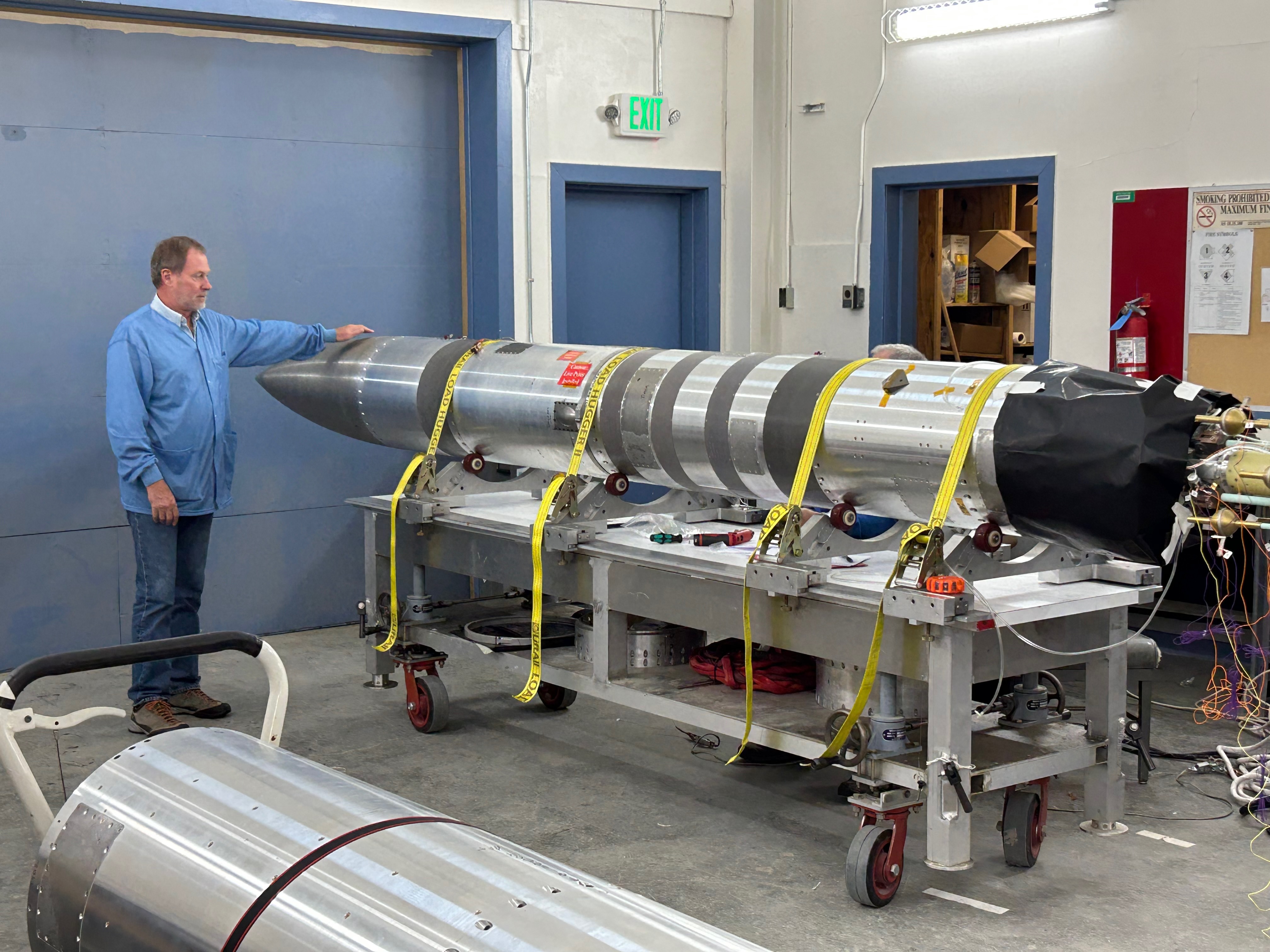The head of NASA’s sounding rocket program called April’s first launches of the space agency’s Solar Flare Sounding Rocket Campaign the “perfect example” of cooperation among facilities, including Poker Flat Research Range northeast of Fairbanks. The range is owned and operated by the University of Alaska Fairbanks Geophysical Institute.
Two Black Brant IX sounding rockets launched moments apart from Poker Flat, on April 17 to gather data about a moderate-sized solar flare.
The launches closed out the rocket range’s 2023-24 season, which included two successful launches in November.
“This campaign, executed by NASA's Wallops Flight Facility Sounding Rockets Program Office, is the perfect example of collaboration between multiple operational sites,” said Giovanni Rosanova, chief of the sounding rocket program.
“The payloads, carrying large telescopes, were initially integrated at White Sands Missile Range in New Mexico and sent to Poker Flat Research Range in Alaska, where we can easily wait for the right science conditions for launch,” he said.
NASA has historically launched its solar sounding rockets from the Army’s White Sands Missile Range in New Mexico. Poker Flat provided greater flexibility for the April launches because its location in a sparsely populated region creates little disruption, allowing for lengthy launch periods. That provided the two lead scientists plenty of time to wait for a suitable solar flare.
The university operates Poker Flat under a contract with Wallops Flight Facility. The Sounding Rockets Program, funded by NASA's Heliophysics Division, is managed at the Wallops facility in Virginia under the agency’s Goddard Space Flight Center in Greenbelt, Maryland.
“The missions were successful because of the highly skilled and dedicated teams working together to pave the way for a new type of science investigation,” Rosanova said of the agency’s decision to use sounding rockets to study solar flares. “We welcome more such campaigns in the coming years.”
Poker Flat Research Range Director Kathe Rich said the 2023-24 was unusual for the range, with launches in November and April rather than the months in between.
“Fall launches have never been done at Poker Flat, mostly because the fall months are generally so cloudy,” she said of the two November launches. “We got clear skies and good conditions at the same time very early in the launch window, which nobody really expected to happen.”
The two April launches were the first solar launches from Poker Flat and were the culmination of four-plus years of work, Rich said.
“We are very pleased that they were such a success,” she said.
The April launches also occurred during daytime, something different for the Poker Flat crew because launches usually occur in the dark for aurora research.
“For our crew it just felt quite strange and a little disorienting to be counting down on a rocket while it was light out,” Rich said.
The nearly two-week daytime launch window also affected aviation around communities in the rockets’ flight path. Flight restrictions were imposed for several hours a day while scientists waited for the right conditions for launch.
Also different with the April launches, the Poker Flat team was required to have two helicopters in Coldfoot on standby to recover payloads within 24 hours.
“I look forward to seeing more solar work in the future as Poker is uniquely qualified to wait for an event and be able to recover a payload so it can be refurbished and reflown,” Rich said. “There are few ranges that are land-based, and those that are have scheduling challenges that make waiting days or weeks for an event difficult.”
The April launches occurred on the last day of the 12-day launch window. The lead scientists had been waiting for the right type of solar flare.
The wait ended just after 2 p.m. on April 17 when they gave the go-ahead for launch. The rockets reached altitudes up to 168 miles, and their instruments were able to observe the large solar flare, according to NASA.
Each rocket carried a separate mission.
The Focusing Optics X-ray Solar Imager mission was the first to launch, at 2:13 p.m. The mission is led by Lindsay Glesener, an associate professor at the University of Minnesota Institute for Astrophysics.
The High Resolution Coronal Imager mission launched at 2:14 p.m. Sabrina Savage at NASA’s Marshall Space Flight Center is the mission’s principal investigator.
The two launches gathered data for heliophysics research and validated new science instruments. Heliophysics deals with the study of the sun and its effects on the solar system, including the Earth and other planetary bodies.
“The teams were getting nervous after the campaign opening was delayed due to some technical issues at the pad and the sun became unusually quiet for several days,” Savage said. “But on the second to the last day of the official window, we got our flare.”
“Both launches were perfect, and both experiments observed the same region at the same time,” she said.
The Geophysical Institute produced a short video where lead scientists Savage and Glesener discuss their excitement for the "Hi-C" and "FOXSI" launches at the Poker Flat Research Range.
The two launches were the last of Poker Flat’s 2023-24 season. Two other launches occurred on successive days in November.
The first of those was for the Dissipation mission, which sought to learn how charged solar wind particles dissipate their energy in the high-latitude ionosphere-thermosphere. Mehdi Benna, an aeronomist and planetary scientist at the University of Maryland, Baltimore County and NASA’s Goddard Space Flight Center, is the experiment’s principal investigator.
“We are still in the process of processing the data and accessing science results,” Benna said in late April. “What we can say for now is that all instruments operated as intended and collected data.”
Associate professor Mark Conde of the UAF Geophysical Institute and UAF College of Natural Science and Mathematics is a co-investigator on that project.
The following day saw the launch of the Beam-Plasma Interactions Experiment, which involved generation of very low frequency radio waves using a pulsed electron beam. The goal was to cause charged particles to rain down from space, along Earth’s magnetic field lines, and into the upper atmosphere.
It is one idea for cleaning near-Earth space after a nuclear detonation at the edge of the planet’s atmosphere. The cleanup would make space safer for satellites.
The mission had a failure in one payload component, however. The electron beam was not being controlled as intended.
Geoff Reeves, chief scientist for the Intelligence and Space Research Division at Los Alamos National Laboratory, said the beam accelerator itself and the mission’s other components appear to have worked as designed but a filter intended to allow only a narrow band of energies to be injected into space appears to have failed.
Reeves is the experiment’s principal investigator.
“So that doesn't allow us to do the really detailed test of plasma physics theory,” he said.
“This was the first accelerator of its kind to be flown in space,” he said. “We knew it was inherently risky, and the mission was designed to have both technological objectives and scientific objectives. The fact that the accelerator worked was great from a technical perspective.”
Reeves said the technology is being improved so it can be used in future proposals, including for a Beam-PIE 2 proposal that he will submit to NASA for a launch at Poker Flat in 2027 or 2028.
